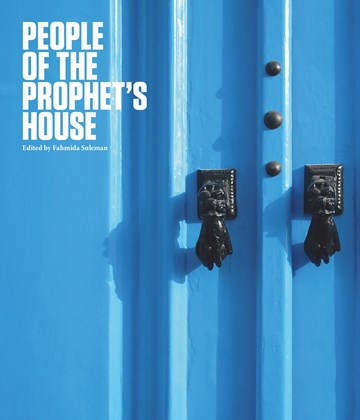People of the Prophet's House Artistic and Ritual Expressions of Shi'i Islam
Azimuth Editions in association with the Institute of Ismaili Studies
Despite their distinct theological differences, Shiʿi and Sunni Muslims, followers of the two main divisions of Islam, share a number of core beliefs including an allegiance to and love for the Prophet Muhammad and members of his family. For Shiʿi Muslims, reverence for the Prophet and allegiance to his household (Ahl al-bayt, People of the House), comprising his immediate family and their descendants, constitutes an essential principle of belief that has directly impacted how Shiʿi artists, rulers, patrons and ritual participants have conveyed their love and loyalty through material culture and religious ritual. The 22 essays in this volume, richly illustrated with over 200 colour images, present a diversity of beliefs and practices expressed through the arts, architecture, material culture and ritual that spans Shiʿi history from the tenth century to the present day. With contributions from experts in the fields of anthropology, religious studies, art and architectural history, numismatics, film studies and contemporary art, the book also calls attention to the global diversity of the artistic and devotional expressions of Shiʿi Muslims from across Trinidad, Senegal, Egypt, Syria, Iraq, Iran, Pakistan, India and China. Additionally, some essays draw upon important female Shiʿi figures and female ritual practices and many chapters underscore the theme of love for the Ahl al-bayt beyond Sunni and Shiʿi demarcations. This work contributes to a growing body of scholarship dedicated to the religious arts and rituals of Shiʿi Muslims around the world.
Part 1: Introduction
1. Shiʿi art and ritual: contexts, definitions and expressions, Fahmida Suleman and Shainool Jiwa
2. Are there Shiʿi forms of art?, Oleg Grabar
Part 2: Pilgrimage and patronage
3. The Shiʿi shrines of Iraq, James W. Allan
4. Glorifying the Imamate: architecture and ritual in the Shiʿi shrines of Syria, Yasser Tabbaa
5. Evanescent meaning: the place of Shiʿism in Fatimid mosques, Jonathan M. Bloom
6. A Shiʿi building boom in 14th-century Qum: the case of the Bagh-i Sabz towers, Robert Hillenbrand
7. Pilgrims and patrons: ziyāra under the Samanids and Bavandids, Melanie Michailidis
Part 3: Inscriptions on art, architecture and coinage
8. Early Qurʾans ‘signed’ by the Shiʿi Imams, Sheila R. Canby
9. Writing about faith: epigraphic evidence for the development of Twelver Shiʿism in Iran, Sheila S. Blair
10. The writing on the walls: selections from the Twelver Shiʿi epigraphs of Lucknow’s Hussainabad Imambara, Hussein Keshani
11. ʿAlī walī Allāh and other non-Qurʾanic references to the Ahl al-bayt on Islamic coinage before the Saljuq period, Luke Treadwell
Part 4: Iconographic studies: Shiʿi contexts and beyond
12. Between the past and the future: The fālnāma (book of omens) in the 16th and early 17th centuries, Massumeh Farhad
13. Exploring Ahl al-bayt imagery in Qajar Iran (1785–1925), Maryam Ekhtiar
14. Shiʿism and contemporary Iranian art, Venetia Porter
15. Dhu’l-faqār and the Ottomans, Zeynep Yürekli
16. The Hand of Fatima: in search of its origins and significance, Fahmida Suleman
Part 5: Ritual expressions
17. Lasting elegy: Shiʿi art and architecture, Peter J. Chelkowski
18.ʿArūze Qāsem – a theatrical event in Shiʿi female commemorative rituals, Ingvild Flaskerud
19. Cinema as a cultural reservoir for the Shiʿi performing art of taʿziya, Nacim Pak-Shiraz
20. Some historic taʿziyas of Multan, Tryna Lyons
21. Chirogh rawshan: Shiʿi ceremonial practised by the Ismaili communities of Xinjiang China, Amier Saidula
22. Building and performing Shiʿi Islam in Sufi Senegal: a photo essay, Mara A. Leichtman
Acknowledgements, note on transliteration and abbreviations
Glossary
Contributors
Photo credits
Select bibliography
Index
Fahmida Suleman (D.Phil, Oxford) is Phyllis Bishop Curator for the Modern Middle East at the British Museum. Her research interests include the Fatimids, religious arts and iconography, and Middle Eastern and Central Asian textiles and jewellery. She is the author of ‘The Image of ʿAli as the Lion of God in Shiʿi Art and Material Culture’, in The Art and Material Culture of Iranian Shiism: Iconography and Religious Devotion in Shiʿi Islam, ed. P. Khosronejad (London, 2012) and editor of Word of God, Art of Man: The Qur'an and its Creative Expressions (Oxford, 2007).

